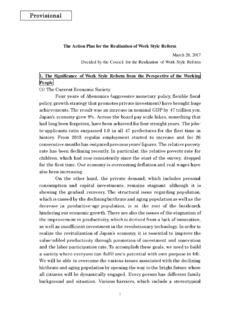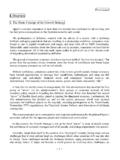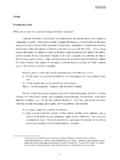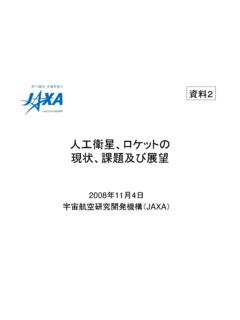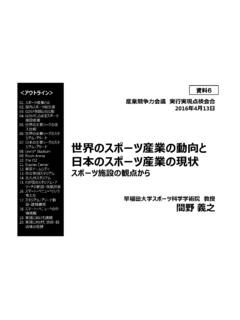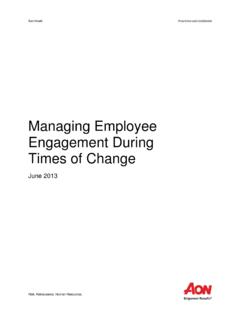Transcription of The Japan’s Plan for Dynamic Engagement of All Citizens
1 Provisional The Japan's plan for Dynamic Engagement of All Citizens 1. The Doctrine of a Mechanism of a Virtuous Cycle of Growth and Distribution (1) Present Economic Society of Japan (Achievements of Abenomis). Three years of Abenomics (aggressive monetary policy, flexible fiscal policy, growth strategy that promotes private investment) have brought huge achievements. Gross national income (GNI) has increased by almost 40 trillion yen and national tax income has also increased by 15 trillion yen. Earnings of Japanese companies are at their highest levels and they are steadily turning into employments and wages.
2 Number of employees has increased by more than million and across-the-board pay increases, which were almost unachievable before the change of government, are expected to be conducted in a large number of companies for the third consecutive year. Number of unemployed people has decreased by approximately million and the unemployment rate hovers around , a figure not seen for 18 years. Jobs to applicant ratio has reached the highest level in 24 years. Price trends have reversed and there has been a trend towards rising prices the last two years. GDP deflator has been positive for the ninth consecutive quarter.
3 GDP gap has continued to decrease in size although it is still negative. (Challenges for the Global Economy). On the other hand, a downward risk and fragility of the global economy are expected to become higher. Many experts expect that economic conditions will become even worse and demand will stagnate worldwide this year. In April, 2016, International Monetary Fund (IMF) revised its outlook for 2016 economic growth of the global economy from (which was a figure projected in January, 2016) to In China, while the nation is promoting a shift toward a growth model which is domestic demand-led and more sustainable, there have been problems pointed out including excessive equipment and bad loans and its economy is gradually decelerating.
4 Growth in equipment is becoming weaker and it is said that the nation will cut down its excessive capacity of crude steel and coal production over several years. In addition, the recent decline in oil prices causes heavy damage to emerging economies including resource-rich nations. How to deal with nefarious terrorism and the refugee issue is another challenge which has huge influence on the global economy. Further, both domestic and international financial markets have 1. occasionally showed unstable movements since the beginning of this year. In this situation, some intellectuals point out that the global economy is in the bust period with continuous high unemployment of youths, growing inequality and possible recession and stagnation.
5 Now, the world is searching for its way toward a sustainable growth. In the world of growing interdependence, the largest theme of the G7 Ise-Shima Summit is how G7. nations can cooperatively cope with risks as described above. G7 nations need to lead the world and show a road map for a sustainable and robust growth of the global economy. In order to avoid risks of crisis beyond business cycles and revitalize the global economy, it is important to promote cooperation on monetary policies, flexible fiscal policies and structural reforms with balance, reflecting the situation of each nation.
6 We need to share and cooperatively cope with various issues and risks which the world is facing. We need to take actions before risks held by the global economy become obvious and the world falls into a crisis. In order to take a significant step of these actions, we announced G7. Ise-Shima Economic Initiative. Many more nations in the world are facing similar problems as Japan in various aspects like decline in the size of working-age population in Europe and decline in the growth rate of working-age population in the United States, as some intellectuals point out.
7 Japan's leadership as a chair of the G7 Ise-Shima Summit has become extremely crucial for the global economy as well as Japanese economy itself. Although Japanese economy is almost at the point of overcoming deflation, real wage increase remains slow and there is a lack of strength in private demands including personal consumption and business investment. This April, the 2016 Kumamoto Earthquake caused extremely severe damages. Also, across the world, there are some important notes that Japan with declining population has no more future. A sustainable growth under the current situation of the declining birthrate and aging population is a cutting-edge issue which can be shared by most of advanced nations as well as emerging nations.
8 We will deliver a Japanese-style mechanism to overcome this issue as a new model of the challenge toward the future of the global economy. (The Declining Birthrate and Aging Population at the Root of the Obstacles in Economic Growth). The structural issue of the declining birthrate and aging population is at the root of the obstacles in economic growth. Over the last 30 years or so, the birthrate has significantly decreased (decreased from in 1984 to in 2005 and has hovered around up to now) and population aging rate has steadily risen (from in 1984 to in 2014).
9 After the peak in 2008, the total population entered a decreasing phase. It is 2. expected that once the population starts to decline, its decline rate will become higher at an accelerated pace. Some estimation predicts that the annual decline rate will be accelerated from approximately million in early 2020s to approximately million in 2040s. As a consequence, the total population is estimated to be less than 50 million about 100 years from now (in 2100). An awareness that this advance in the declining birthrate and aging population not only reduces the labor supply but also causes a reduction in the size of the economy and a lowered standard of living and therefore threatens the economic sustainability leads to anxieties and pessimism about the future.
10 Without our serious struggle against the declining birthrate and aging population, continuous investments into Japan will be hopeless. This is a conclusion obtained on the first stage of Abenomics. On the other hand, there are lots of women holding enormous potentialities and the elderly who are vigorous and energized, having abundant experiences and wisdoms. Now is the time to tackle the structural issue of the declining birthrate and aging population head on as the whole Cabinet, utilizing potentialities as described above and the fruits of Abenomics. (2) Basic Stance for Future Measures (Significance of a Society in Which All Citizens are Dynamically Engaged).
